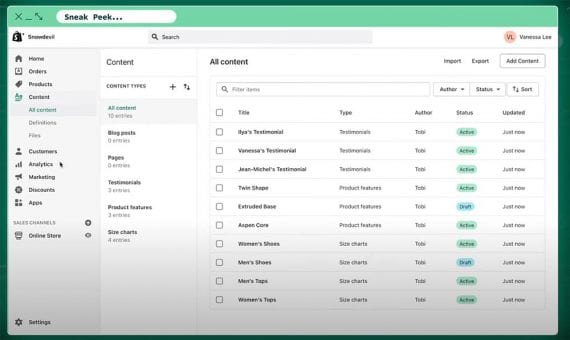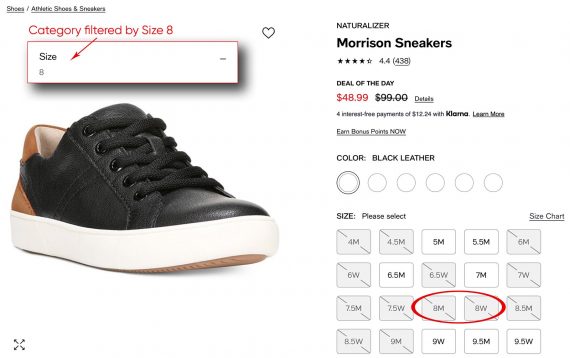“We have always said we want to create more opportunities for our developers and our partners than we take for ourselves,” said Shopify President Harley Finkelstein about 57 minutes into the live event.
“The opportunities keep getting bigger. Last year our partner ecosystem generated .5 billion in revenue. And that number is up more than 84% from 2019,” said Finkelstein, adding, “that is four times more than Shopify made, and that is the way it should be. We only succeed when you do.”
“We know that content is super important when it comes to expressing a shop’s brand, and soon you will be able to create entirely new custom [content] types…you will be able to create content once and publish it to all of your channels, including the online store,” Lee said, adding that Shopify planned to work with existing content management platforms in some way.
[embedded content]
Online Store 2.0
Perhaps the second most interesting announcement at Shopify Unite was the company’s new app and theme revenue sharing model.
App and theme developers heard plenty of good news, beyond the new revenue model, during the live event.
In addition to the new editor, Lee shared a “sneak peek” of Shopify’s soon-to-be-released content management system.
If the demonstrations Shopify shared are indicative, the new online editor will make it possible for small and midsized businesses to easily create new page templates and populate them with data without writing code — assuming the theme employed makes use of Shopify’s sections and blocks.
- Themes and the online editor,
- Store content,
- Developer tools.
For small business owners and managers, the most significant announcement may have been the aforementioned Online Store 2.0 or at least a portion of it.
Shopify updated its templating language, called Liquid, which now includes an editor similar in performance to WordPress’s Gutenberg, released in 2018, or to the page editors in Squarespace and Wix.
Netflix’s recently-announced merchandise store uses the new theming approach, for example. And Shopify has released a new theme called Dawn that is an “open-source reference theme, built for performance, flexibility, and ease of use. It uses Online Store 2.0 features, including JSON templates, which support app blocks and sections on all pages,” according to Shopify.
Storefront API. Shopify added to its Storefront API, allowing for new cart capabilities, including the ability to pass relevant buyer context (such as country or state) with the GraphQL API and a new option to query physical store inventory to power buy-online-pick-up-in-store solutions.
Shopify also released articles and resources related to the Unite announcements.


This upgraded editor may replace some popular Shopify apps, including the Shogun page builder.
Improvements. Shopify improved its documentation and command-line interface, added GitHub support, and created a new developer console for performance testing.


Zero Percent Revenue Share
Checkout API. Shopify introduced checkout extensions, a set of extension points, APIs, and user interface components — all could be used to build apps for checkout.
Finkelstein went on to say that effective August 1, 2021, Shopify would no longer take any share of the revenue from apps or themes up to million per year sales. After million in sales, Shopify will take 15%, reducing its previous revenue share of 20%.
Hydrogen. Shopify has a new React-powered “developer toolkit that includes scaffolding to help get you up and running with only a few clicks, and a set of React components to help you build the foundation of your commerce website, so you can focus on styling and designing the features that make a merchant’s brand unique.”
Although the company also introduced a registration fee for apps after August 1, 2021, the new revenue-sharing model encourages developers to create apps and themes for Shopify. It may also seek to avoid some of the app-store strife seen in mobile, such as the recent lawsuit between Epic Games and Apple.
[embedded content]
Developers
Unless you are a developer, the new online editor and the forthcoming content management system will likely be the most impactful.
During a live event on June 29, 2021, called Shopify Unite, aimed at entrepreneurs and the Shopify development community, the ecommerce platform demonstrated several updates and changes, including what it termed “Online Store 2.0.”
Netflix’s merchandise store uses Shopify’s new upgrades.
Shopify plans to give store managers more options for content.
“Today I am going to show you the biggest and boldest upgrade we have ever shipped to the online store,” said Vanessa Lee, Shopify’s online store product director. “Our goal is to give more power to developers while making it even easier for merchants to leverage that power and build their storefront.”
Resources
The complete presentation, which ran for about 75 minutes, is available on YouTube.






![[Infographic] 21 Things You Didn’t Know About Search Ads](https://research-institute.org/wp-content/uploads/2022/08/infographic-21-things-you-didnt-know-about-search-ads.png)